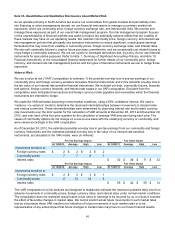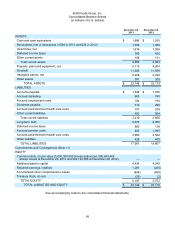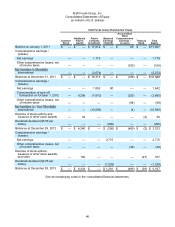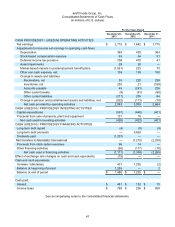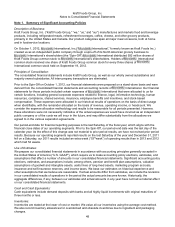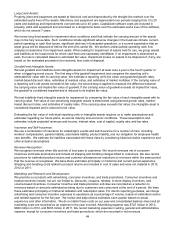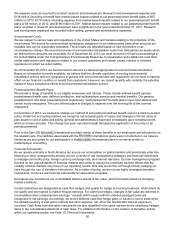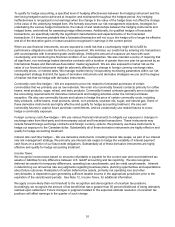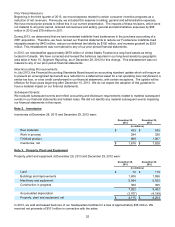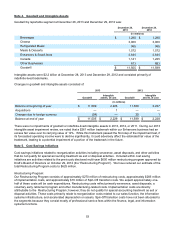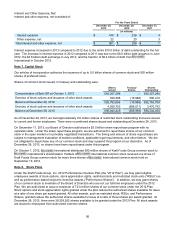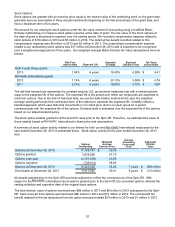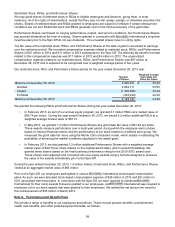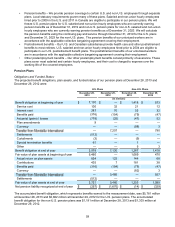Kraft 2013 Annual Report Download - page 53
Download and view the complete annual report
Please find page 53 of the 2013 Kraft annual report below. You can navigate through the pages in the report by either clicking on the pages listed below, or by using the keyword search tool below to find specific information within the annual report.51
To qualify for hedge accounting, a specified level of hedging effectiveness between the hedging instrument and the
item being hedged must be achieved at inception and maintained throughout the hedged period. Any hedging
ineffectiveness is recognized in net earnings when the change in the value of the hedge does not offset the change
in the value of the underlying hedged item. We formally document our risk management objectives, strategies for
undertaking the various hedge transactions, the nature of and relationships between the hedging instruments and
hedged items, and method for assessing hedge effectiveness. Additionally, for qualified hedges of forecasted
transactions, we specifically identify the significant characteristics and expected terms of the forecasted
transactions. If it becomes probable that a forecasted transaction will not occur, the hedge will no longer be effective
and all of the derivative gains or losses would be recognized in earnings in the current period.
When we use financial instruments, we are exposed to credit risk that a counterparty might fail to fulfill its
performance obligations under the terms of our agreement. We minimize our credit risk by entering into transactions
with counterparties with investment grade credit ratings, limiting the amount of exposure we have with each
counterparty, and monitoring the financial condition of our counterparties. We also maintain a policy of requiring that
all significant, non-exchange traded derivative contracts with a duration of greater than one year be governed by an
International Swaps and Derivatives Association master agreement. We are also exposed to market risk as the
value of our financial instruments might be adversely affected by a change in foreign currency exchange rates,
commodity prices, or interest rates. We manage market risk by incorporating monitoring parameters within our risk
management strategy that limit the types of derivative instruments and derivative strategies we use and the degree
of market risk that we hedge with derivative instruments.
Commodity cash flow hedges – We are exposed to price risk related to forecasted purchases of certain
commodities that we primarily use as raw materials. We enter into commodity forward contracts primarily for coffee
beans, meat products, sugar, wheat, and dairy products. Commodity forward contracts generally are not subject to
the accounting requirements for derivative instruments and hedging activities under the normal purchases
exception. We also use commodity futures and options to hedge the price of certain commodity costs, including
dairy products, coffee beans, meat products, wheat, corn products, soybean oils, sugar, and natural gas. Some of
these derivative instruments are highly effective and qualify for hedge accounting treatment. We also sell
commodity futures to unprice future purchase commitments, and we occasionally use related futures to cross-
hedge a commodity exposure.
Foreign currency cash flow hedges – We use various financial instruments to mitigate our exposure to changes in
exchange rates from third-party and intercompany actual and forecasted transactions. These instruments may
include forward foreign exchange contracts and foreign currency options. We primarily use these instruments to
hedge our exposure to the Canadian dollar. Substantially all of these derivative instruments are highly effective and
qualify for hedge accounting treatment.
Interest rate cash flow hedges – We use derivative instruments, including interest rate swaps, as part of our interest
rate risk management strategy. We primarily use interest rate swaps to hedge the variability of interest payment
cash flows on a portion of our future debt obligations. Substantially all of these derivative instruments are highly
effective and qualify for hedge accounting treatment.
Income Taxes:
We recognize income taxes based on amounts refundable or payable for the current year and record deferred tax
assets or liabilities for any difference between U.S. GAAP accounting and tax reporting. We also recognize
deferred tax assets for temporary differences, operating loss carryforwards, and tax credit carryforwards. Inherent
in determining our annual tax rate are judgments regarding business plans, planning opportunities and expectations
about future outcomes. Realization of certain deferred tax assets, primarily net operating loss and other
carryforwards, is dependent upon generating sufficient taxable income in the appropriate jurisdiction prior to the
expiration of the carryforward periods. See Note 12, Income Taxes, for additional information.
We apply a more-likely-than-not threshold to the recognition and derecognition of uncertain tax positions.
Accordingly, we recognize the amount of tax benefit that has a greater than 50 percent likelihood of being ultimately
realized upon settlement. Future changes in judgment related to the expected ultimate resolution of uncertain tax
positions will affect earnings in the quarter of such change.


